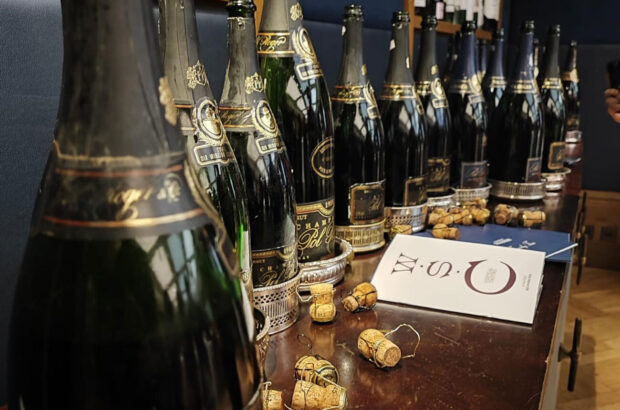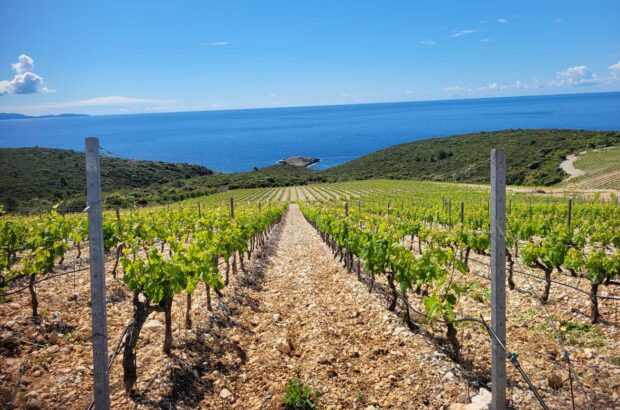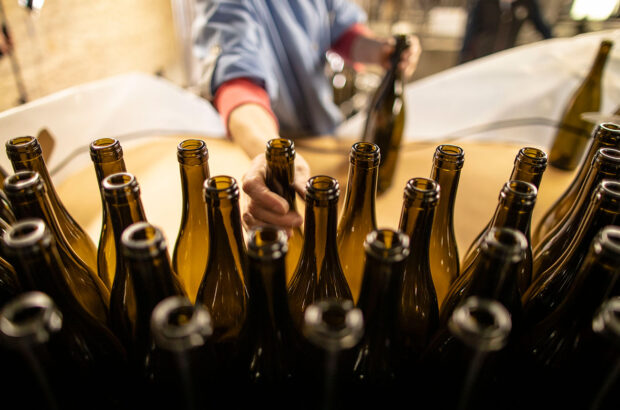Bordeaux remains a favourite destination for wine-touring holidays. But with 6,500 estates here, where do you start? Selecting châteaux that are near to each other but show differing approaches can be a fun and rewarding way to plan your trip, as with every visit you put a new piece of the puzzle into place. Each pair of châteaux described here can be visited in one day, allowing for a long, slow lunch in between, or a walk through the nearby countryside.
White vs red
Carbonnieux & Haut-Bailly
Although Bordeaux is 90% red wine, there are many brilliant white wines to discover in the region, and splitting your day between both is a fascinating reminder that for much of the 20th century, Bordeaux made more white than red. You will find examples of white wines all over Bordeaux, and you could easily do this pairing in several appellations (try Château Thieuley/Château de Reignac in Entre-Deux-Mers, or Château Chantegrive/Château de Portets in Graves) – but for Bordeaux’s best-known whites, head to Pessac-Léognan.
Morning
Château Carbonnieux, Pessac-Léognan CCG
Owned by brothers Eric and Philibert Perrin (no relation to the Château de Beaucastel Perrins in the Rhône), this wonderful estate is pretty much split down the middle into the production of red and white wine, with 50ha of red and 42ha of white – more of the latter than any other Pessac-Léognan estate. The resulting white is a brilliant wine full of creamy concentration, made with the two best-known local varieties, Sauvignon Blanc and Semillon. It’s an excellent estate to visit: the property dates back to the 13th century, and for a long time was owned by Benedictine monks known for their exceptional white wines. In 1786, Thomas Jefferson visited and left his mark by planting an American pecan tree, which still stands today.
There are a range of tours available here, from the ‘Classic’ €10 tour with a tasting of two wines, to the ‘Prestigious’ tour for €20, with a tasting of three wines and a food platter. A food and wine matching workshop is also on offer, pairing five cheeses and three wines for €22. Open Monday to Friday all year, plus Saturdays from May to October.
Afternoon
Château Haut-Bailly, Pessac-Léognan CCG
Only red wine is made at this 30ha American-owned estate, and it is easily some of the best in the whole of Bordeaux. It’s just along the road from Carbonnieux, so making a visit between the two properties is easy and enjoyable on foot or by bike if you are staying in the area. The wine is classically graceful, full of softly curling woodsmoke, tobacco and rich black fruits – the tasting here is a must. The Haut-Bailly estate’s history can be traced back to at least 1461, and the current château is from the 19th century, standing in contrast to the sleek modern cellars. It boasts a well-stocked boutique that sells books, picnic gear and a ton of interesting gifts. For special occasions, you can arrange private dining with the on-site chef. A new winery is currently under construction.
A number of different visits are on offer, ranging from €20 for one hour, to €50 for the 90-minute ‘Collector’s’ session. All include a tour and tasting.
Cutting edge vs low tech
Montrose & Pontet-Canet
These are two of Bordeaux’s most celebrated and iconic names, both producing incredible wines but reaching their goals by entirely different routes. A day spent visiting one and then the other is eye-opening.
Morning
Château Montrose, St Estèphe 2CC
Head up to St-Estèphe, where you’ll find Château Montrose along the banks of the Garonne river, the far end of its vineyards practically grazing the fishermen’s huts along the river. One of the most impressive châteaux to visit in Bordeaux, this 90ha estate is at the cutting edge of vineyard technology with a stunning 10,000m2 cellar and luxurious design touches at every turn. It is also one of the greenest châteaux in the region, with geothermal technology, a permaculture orchard, a system for capturing the carbon dioxide produced during fermentation and the use of electric tractors in the vineyard. Full organic certification is due in 2020, and in the vineyard things are obsessively tracked and recorded to ensure precision viticulture. The number of plots, for example, stood at 24 when director Hervé Berland arrived in 2011. Today there are 110, the result of dividing and sub-dividing to ensure that all the tiny differences between the plots are respected throughout the growing season and at harvest. You will leave astonished by how much expense, effort and expertise goes into making the greatest wines of Bordeaux.
There is no fee to visit, but you do need to book your tour in advance.
Afternoon
Château Pontet-Canet, Pauillac 5CC
Just a 15-minute drive south and you cross over into Pauillac, home of the iconic classified estate of Pontet-Canet. You’d be forgiven for thinking that you’ve stepped back in time, as owner Alfred Tesseron and director Jean- Michel Comme have gone resolutely old- school. Farming is organic, as at Montrose, and also biodynamic, with all biodynamic preparations made on-site. There are even eight Breton draft horses used for vineyard work across at least half of the 81ha estate – if they aren’t out working, you can visit them in their well-kept stables. Cellar work is equally traditional. Everything is manual, from destemming and sorting at harvest, to filling cement vats made out of the sand, clay and gravel taken from the surrounding land during the construction of a cellar extension. No electricity is allowed anywhere near the vats, except for LED lighting, and everything is powered by geothermal energy.
There is no fee, but visits here are typically reserved for professionals only, though they may be extended to wine-tasting groups, sommeliers and collectors – it’s definitely worth trying.
Historic vs newly created
Château de La Rivière & George 7
Over its 2,000 years of winemaking history, Bordeaux has continually reinvented itself, helped by constant innovation and new arrivals. Nothing brings that home more clearly than a day visiting one of its oldest and one of its newest estates. And Fronsac on the Right Bank is a lovely place to do this, with views over the Dordogne and Isle rivers.
Morning
Château de La Rivière, Fronsac
Among the oldest châteaux in Bordeaux, this stunning property was constructed in 1577 by Gaston de l’Isle on the remains of a defensive camp built by Charlemagne. It’s hard to miss, as it stands tall over the countryside on 100ha of parkland and gardens that are worth a visit. Best of all are the 8ha of limestone caves that are still used for ageing the wine. They offer a brilliant way to get up close to the limestone terroir that dominates not only Fronsac but also St-Emilion, Castillon and beyond. A range of visits are geared to different audiences, including families. You can even order a picnic to eat in the beautiful courtyard. Although it’s a French-run estate, the owners are Chinese, so you might also want to try the pu’er tea ceremony (€25) to learn the history of this traditional tea, with a tasting.
Open Monday to Friday all year, plus Saturdays from May to October. Visits are by appointment only. A cellar tour and tasting costs €9, while a cellar tour and a tasting of individual grape varieties to show Right Bank and Left Bank differences is €25.
Afternoon
Château George 7, Fronsac
For something completely different, head to the tiny Château George 7, created only a few years ago by British owner Sally Evans, who changed career to become a winemaker armed only with a WSET Diploma and a positive attitude. It’s not easy to find completely new estates in Bordeaux, and it’s fascinating to hear about her journey: finding a run-down farm, converting it into a house and equipping an empty cellar building. As for the château name, George means ‘tiller of soil’ in Greek; it’s also a reference to the English patron saint. And the 7? It’s possible that Prince William’s son George may one day take the name George VII, so Evans used this part of the name to ‘pay tribute to the old while venturing into the new’, as she puts it. The château opened for business in 2017, although the first vintage was almost entirely wiped out by frost, making 2018 the true inaugural year. You get to see real hands-on winemaking here – with a bit of help from her consultants, Evans picks the grapes, prunes the vines, and lugs the barrels around. Thank goodness it’s only 3ha at this stage. She is also very happy to share her experiences and motivations with others who might be looking to get into winemaking. She can also help you arrange an electric bike tour around Fronsac – particularly useful, as there are some steep slopes in this appellation.
There is no fee for visits, which can be arranged on any day of the week subject to availability, strictly by appointment.
Left Bank vs Right Bank
Château de Lamarque & Peybonhomme-Les-Tours
It’s not easy to take in both banks in a single day without quite a bit of driving, but this would be a novel way to do it – heading from AP Haut-Médoc over to AP Blaye via the ferry that runs between Lamarque and Blaye. You can take your car on board the ferry. Refer to the tourism website Bernezac for timetables.
Morning
Château de Lamarque, Haut-Médoc
One of the most amazing châteaux in the Médoc, located between Margaux and Pauillac, Lamarque should be far better known to wine tourists. It’s definitely worth spending a full morning here as there is so much history to soak in, and extremely charming owners to take you through it. The château itself is, in part, 1,000 years old, built originally as a fortress by Garsion de Lamarque to counter the lingering threat of Viking raids. It is perfectly preserved, with a 13th-century keep where the family’s private wine collection is stored. A former chapel dates back to the 11th century, and even the winery contains a row of well-preserved old oak vats, which conceal a more modern interior. The current owner, Pierre-Gilles Gromand-Brunet d’Evry, is a direct descendant of Garsion de Lamarque.
It’s an excellent Haut-Médoc wine to boot. Visits and tastings are by appointment only.
Afternoon
Château Peybonhomme-Les-Tours, Blaye
You’re going to want to head to the Citadelle de Blaye when you disembark from the ferry, as this UNESCO World Heritage fortress built by renowned military engineer Vauban is one of the best preserved in France. There is a small vineyard there, and you can attend a wine tasting in the Cellier des Vignerons. However, Blaye is also a great place to visit an estate, as lots of owners live on site. I would recommend Peybonhomme-Les-Tours in the commune of Cars, overlooking the estuary.
It is certified biodynamic, with great wines produced by the welcoming Bossuet-Hubert family. There are several wines to look out for, particularly amphora-aged bottling Energies and a sparkling blanc de noir – all low sulphur and showcasing the many interesting developments happening in Bordeaux with a more hands-off, natural approach to winemaking.
Visits are by appointment only.
Literary vs artistic
Château Malromé & Malagar
If you are a fan of books or art, there are two estates that give you the pick of both, about 50km to the southeast of Bordeaux on the edge of Entre-Deux-Mers.
Morning
Château Malromé, Bordeaux Supérieur
Art lovers shouldn’t miss this 45ha estate at St-André-du-Bois – it dates back to the 14th century and has been delivering harvests without stopping through wars and revolutions ever since. Best known for its connection to the artist Henri de Toulouse-Lautrec, it was owned by his mother and he died here in 1901. It’s worth a visit for its Toulouse-Lautrec exhibition – you can walk through his apartments and see some of his original sketches, including 19th-century graffiti – but also for its contemporary art foundation. The new Franco-Vietnamese owners, Kim Valéry Huynh and his daughters Mélanie and Amélie, hold regular exhibitions. There is also a restaurant, Adèle (named after Toulouse-Lautrec’s mother) – an outpost of the popular Claude Darroze restaurant in Langon – that is open Wednesday to Sunday and has an excellent Sunday brunch.
A guided visit is €12, including a tasting. Access to the Toulouse-Lautrec apartment is available only through the guided tour.
Afternoon
Domaine de Malagar, Côtes de Bordeaux
Although you can see vines around this property near St-Maixant, the wine sold here is produced by Jean Merlaut in a winery at the bottom of the hill, close by but not open to the public. Called Château Malagar, it is made in Côtes de Bordeaux red, AP Bordeaux white and rosé, and sweet white Premières Côtes de Bordeaux. In addition to buying wine at Malagar, you can also check out an exhibition about the life of one of Bordeaux’s most famous authors, François Mauriac, winner of the Noble Prize in Literature in 1952, who used to live here. But one of the best things that you can do when visiting Malromé and Malagar is walk – there is a footpath that connects the two estates. The 7km journey is open to any enthusiastic hiker, and twice a year the estates host a joint celebration called Sur le Coteau des Artistes, where you start at Malromé with a visit and a tasting, then walk over to Malagar for a picnic followed by a visit, then return by a different footpath. It’s a full day, but a wonderful way to get to know the beautiful landscape around the Garonne valley in this part of Bordeaux. The dates for 2020 had not yet been announced at the time of this magazine’s publication.
Open daily from February to November. A guided visit is €8, including a tour of the house, the Mauriac exhibition and the park.












